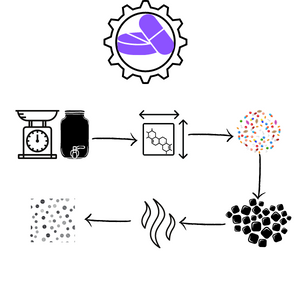Tablet manufacturing equipment is one of the critical pieces of equipment in the pharmaceutical industry. These are used to produce tablet forms of the oral dosage form.
Tablet manufacturing equipment is used to manufacture oral tablet forms of pharmaceutical dosage. It consists of a series of machines and instruments that produce intermediate products. The output of one device or tool becomes the input of its next stage machine or device until the final finished form of a tablet is produced.

Tablet manufacturing equipment
Following are some standard machines and tools in tablet manufacturing equipment
Weighing and Dispensing
Weighing and dispensing transfer the calculated amount of raw material from bulk quantity storage. These estimated quantities are then used to manufacture pharma products of specific amounts and properties.
Weighing and dispensing is a dedicated facility or area for these processes. It must be built separately from the production area to prevent cross-contamination.
Weighing Scale: Weighing scales are used to weigh the required quantities of raw material. They must be accurate and precise enough to weigh the actual quantity of the raw material. The weigh Scale must be calibrated to prevent deviation in the output measurement. In addition to calibration, they must be checked daily, verified against standard weight, and recorded.
Utensils: utensils are commonly used when weighing, dispensing, and transferring raw material from different containers and locations. They must be non-reactive with the material to prevent affecting the raw material. Utensils must be made up of stainless steel.
Sizing equipment
Sizing equipment is used to make particles of uniform approved sizes. If sizing is not performed, it can affect the production process, the drug’s therapeutic effect, and overall yield and increase waste.
Common equipment used in the sizing process is milling equipment. It uses mechanical energy to break larger particles into fine particles of uniform sizes. There are two types of mills used – Wet Mill and Dry Mill.
Blender
It is used to evenly mix different chemicals, API, and excipients in powdered form. Blender consists of a large metallic structure in which the powder is contained. Depending on the blender types and product requirements, the container moves (rotates) or remains fixed.
Fixed Shell Blender: in this type, a metallic container remains fixed during the blending process, and a metallic assembly, called Impeller or mixer, mixes the powder. This blender can produce a relatively higher force to blend chemicals.
Rotating Shell Blender: in this type, the shell in which the material is contained rotates. The material inside the shell mixes through the action of gravity. The mixing force is less than compared to the fixed shell blender.
Granulator
Granulator is used to produce granules out of the powder. Granules are relatively larger and are formed when powders of small particles are combined. There are two types of granulators – Wet and Dry.
A wet granulator uses water or any organic solvent sprayed inside the granulator on the mixing powder. When the powdered form acquires the desired granular shape and size, the process is stopped.
The dry granulator does not use water or organic solvent. Instead, the powder is passed through a roller compactor, forcing it as it gives. The resultant output is the sheet form, broken down into desired smaller particles.
Dryer
The dryer is used to remove the liquid solvent or water content from the granules obtained from the granulator in the granulation stage. The material output from the granulator is directly fed into the dryer, which then removes the water content from the granules. The moisture level is continuously monitored, so it does not fall below acceptable levels.
There are different types of dryers used in the pharmaceutical industry. Two of the common are Fluid Bed Dryer and Tray Dryers.
Tablet Press Machine
A tablet press machine is used to form tablets from the granluidules. In the tablet press machine, granules are pressed in die with upper and lower punches. Compression force is applied at the upper punch, which transfers the force to the powder into the die. After compression, tablets are ejected from the die through the ejection system.
In the tablet press machine, the most critical part is the compression tooling. It refers to the set of punches and dies, which decides the physical characteristics of the output tablet. Two types of tablet tooling are common in tablet press machines – B type and D type.
One of the critical parameters is tablet hardness. It is directly proportional to the compression force applied to the punches. The higher the force, the higher the hardness, and vice versa.
For some product types, the tablet press machine is the final stage equipment for manufacturing tablets. For these types, tablets are directly sent to the packaging department to pack into their relevant packaging.
Tablet Coating Machine
The tablet coating machine is the last manufacturing equipment if the product requires coating.
In a tablet coating machine, tablets are coated with the desired solvent. The machine consists of a large pan, which continuously rotates. Hot air also passes through the pan from the inlet and output pipes. A spray gun sprays the required solvent into the pan containing tablets. As the sprayed liquid touches the tablet’s surface, it sticks to it and forms a coating layer.
After the coating cycle has been completed for a specific time or desired parameters have been achieved, the coating process is stopped.
The finished tablets are removed from the coating and sent to the packaging department for final packing.

